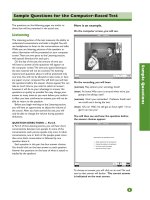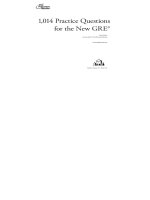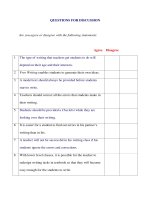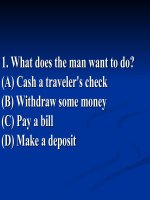Questions for chapter 4
Bạn đang xem bản rút gọn của tài liệu. Xem và tải ngay bản đầy đủ của tài liệu tại đây (44.65 KB, 5 trang )
Chapter 4 - Questions
1. What are the six steps in negotiating the legal framework of the Contract?
The applicable law: Choice of law.
Contract or no contract: Meeting of minds, capacity, legality,
consideration.
Entire agreement: Whereas recital, contract documents, definitions.
The parties: Identity, naming, notices, assignment
Status of the contract: Termination, cancellation, rescission,
language.
Settlement of disputes: Amicable settlement, arbitration, litigation.
2. What are the main differences between Anglo-American Law &Continental
Law?
Anglo-American is based on case-law, Continental Law is fully legalized.
3. Give the main characteristics of Continental Law?
Consistency and uniformity of enforcement.
Predictable.
Brief.
Nationally accepted.
4. Give the main characteristics of Anglo-American Law?
Justice in the individual case.
Not fully predictable.
Long and detailed.
Internationally accepted.
5. What does the applicable law govern?
Questions concerning the validity, interpretation and performance of the
contract.
6. What are the principles of an enforceable contract?
The parties archive a "meeting of mind" referring to mutual agreement.
The parties are capable of entering a contract.
The purpose of a contract is legal.
7. When does a contract come into existence?
A contract comes into existence when one party makes an offer and another
party accepts it.
8. Who are unable to sign contracts?
Those who look un-contractual capacity; e.g. Children, the feeble-minded
and drunks.
9. What does “ultra vires” mean?
Beyond its powers = Under the public law (company law) of many
countries, a company only sign a contract that is within its powers.
A contract that is ultra vires is unenforceable.
10.When is the agreement unenforceable?
When the purpose (or effect) of an agreement is illegal.
11.Name 2 types of agreements under Anglo- American systems
Agreements in which one side has only rights and the other side has only
duties.
Agreements in which both sides have rights and duties.
12.Which kind of agreement is not a contract?
Agreements in which one side has only rights and the other side has only
duties.
13.What is the Entire Agreement?
The final written version of the contract that replaces all previous
agreement between the parties.
14.What is The Whereas Recital? Why is it necessary?
The word "whereas" means "because" or "considering that". Whereas clauses are not provisions, promises or conditions - they are explanations.
A typical whereas - recital contains many types of background information.
When the dispute arises, the judge must ask some background questions.
15.What should appear at the head of the contract?
The official/full registered names of the parties.
16.What is discharge by performance?
The contract is discharge by performance when both parties perform their
duties exactly according to the contract and the last duty is fully performed.
17.What is termination? Name the two types of termination:
One side may have the right under the contract to end contract.
There are 2 types of termination:
Termination for convenience.
Termination for default.
18.What is Termination for convenience?
Termination for convenience occurs when one party (usually the buyer)
simply decides to drop the contract. No reason is required. The buyer must
pay for all work performed or partly performed
19.What is Termination for default?
Termination for default occurs when the contract names certain defaults
which allow one side (usually the buyer) to terminate.
20.What is Cancellation?
Cancellation occurs when one party breaches a contract, the other has the
right to demand cancellation of the contract.
21.What is the difference between termination and cancellation?
The contract is terminated under a provision of the contract.
The contract is cancelled when one side has breached and the other simply
refuses to proceed.
22.What is Rescission?
The parties many simply agree to end their contractual relationship.
23.What are the ways to solve disputes?
There are 3 ways:
Conciliation: an amicable settlement.
Arbitration: a panel of arbitrators solves the disputes.
Litigation: settlement by the court.
24.What are characteristics of litigation?
Litigation before the courts is internationally the least attractive.
It is public.
It is expensive.
It is time-consuming.
The results are often legalistic rather than business like.
25.What are the advantages of using a panel of arbitrators?
Quick.
Costs are predictable.
Decision is business-oriented.
26.What does the arbitration clause specify?
How many arbitrators sit in the court?
Where does the court sit?
What is the language of the court?
Who pays court costs?









